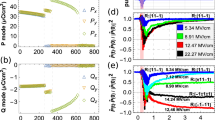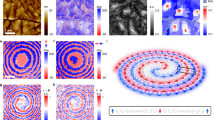Abstract
The optical control of ferroic properties is a subject of fascination for the scientific community, because it involves the establishment of new paradigms for technology1,2,3,4,5,6,7,8,9. Domains and domain walls are known to have a great impact on the properties of ferroic materials1,2,3,4,5,6,7,8,9,10,11,12,13,14,15,16,17,18,19,20,21,22,23,24. Progress is currently being made in understanding the behaviour of the ferroelectric domain wall, especially regarding its dynamic control10,11,12,17,19. New research is being conducted to find effective methodologies capable of modulating ferroelectric domain motion for future electronics. However, the practical use of ferroelectric domain wall motion should be both stable and reversible (rewritable) and, in particular, be able to produce a macroscopic response that can be monitored easily12,17. Here, we show that it is possible to achieve a reversible optical change of ferroelectric domains configuration. This effect leads to the tuning of macroscopic polarization and its related properties by means of polarized light, a non-contact external control. Although this is only the first step, it nevertheless constitutes the most crucial one in the long and complex process of developing the next generation of photo-stimulated ferroelectric devices.
This is a preview of subscription content, access via your institution
Access options
Access Nature and 54 other Nature Portfolio journals
Get Nature+, our best-value online-access subscription
$29.99 / 30 days
cancel any time
Subscribe to this journal
Receive 12 print issues and online access
$209.00 per year
only $17.42 per issue
Buy this article
- Purchase on Springer Link
- Instant access to full article PDF
Prices may be subject to local taxes which are calculated during checkout



Similar content being viewed by others
References
Rubio-Marcos, F., Del Campo, A., Marchet, P., Romero, J. J. & Fernández, J. F. Ferroelectric domain wall motion induced by polarized light. Nat. Commun. 6, 6594 (2015).
Manz, S. et al. Reversible optical switching of antiferromagnetism in TbMnO3. Nat. Photon. 10, 653–656 (2016).
Iurchuk, V. et al. Optical writing of magnetic properties by remanent photostriction. Phys. Rev. Lett. 117, 107403 (2016).
Ying, C. Y. J. et al. Light-mediated ferroelectric domain engineering and micro-structuring of lithium niobate crystals. Laser Photon. Rev. 6, 526–548 (2012).
Boes, A. et al. Direct writing of ferroelectric domains on strontium barium niobate crystals using focused ultraviolet laser light. Appl. Phys. Lett. 103, 142904 (2013).
Guo, R. et al. Non-volatile memory based on the ferroelectric photovoltaic effect. Nat. Commun. 4, 1990 (2013).
Sando, D. et al. Large elasto-optic effect and reversible electrochromism in multiferroic BiFeO3. Nat. Commun. 7, 10718 (2016).
Yang, S. Y. et al. Above-band gap voltages from ferroelectric photovoltaic devices. Nat. Nanotech. 5, 143–147 (2010).
Choi, K. J. et al. Enhancement of ferroelectricity in strained BaTiO3 thin films. Science 306, 1005–1008 (2004).
Seidel, J. et al. Conduction at domain walls in oxide multiferroics. Nat. Mater. 8, 229–234 (2009).
McGilly, L. J., Yudin, P., Feigl, L., Tagantsev, A. K. & Setter, N. Controlling domain wall motion in ferroelectric thin films. Nat. Nanotech. 10, 145–150 (2015).
Agar, J. C. et al. Highly mobile ferroelastic domain walls in compositionally graded ferroelectric thin films. Nat. Mater. 15, 549–556 (2016).
Kwak, B. S. et al. Strain relaxation by domain formation in epitaxial ferroelectric thin films. Phys. Rev. Lett. 68, 3733–3736 (1992).
Li, D. & Bonnell, D. A. Controlled patterning of ferroelectric domains: fundamental concepts and applications. Annu. Rev. Mater. Res. 38, 351–368 (2008).
Eerenstein, W., Mathur, N. D. & Scott, J. F. Multiferroic and magnetoelectric materials. Nature 442, 759–765 (2006).
Mathur, N. A desirable wind up. Nature 454, 591–592 (2008).
Catalan, G., Seidel, J., Ramesh, R. & Scott, J. F. Domain wall nanoelectronics. Rev. Mod. Phys. 84, 119 (2012).
Béa, H. & Paruch, P. A way forward along domain walls. Nat. Mater. 8, 168–169 (2009).
Bibes, M. Nanoferronics is a winning combination. Nat. Mater. 11, 354–357 (2012).
Matsukura, F., Tokura, Y. & Ohno, H. Control of magnetism by electric fields. Nat. Nanotech. 10, 209–220 (2015).
Feig, L. et al. Controlled stripes of ultrafine ferroelectric domains. Nat. Commun. 5, 4677 (2014).
Sluka, T., Tagantsev, A. K., Bednyakov, P. & Setter, N. Free-electron gas at charged domain walls in insulating BaTiO3. Nat. Commun. 4, 1808 (2013).
Salje, E. K. H. Multiferroic domain boundaries as active memory devices: trajectories towards domain boundary engineering. ChemPhysChem. 11, 940–950 (2010).
Farokhipoor, S. et al. Artificial chemical and magnetic structure at the domain walls of an epitaxial oxide. Nature 515, 379–383 (2014).
Seidel, J. et al. Efficient photovoltaic current generation at ferroelectric domain walls. Phys. Rev. Lett. 107, 126805 (2011).
Liu, S. et al. Ferroelectric domain wall induced band gap reduction and charge separation in organometal halide perovskites. J. Phys. Chem. Lett. 6, 693–699 (2015).
Mokrý, P., Tagantsev, A. K. & Fousek, J. Pressure on charged domain walls and additional imprint mechanism in ferroelectrics. Phys. Rev. B 75, 094110 (2007).
Pérez-Junquera, A. et al. Crossed-ratchet effects for magnetic domain wall motion. Phys. Rev. Lett. 100, 037203 (2008).
Acknowledgements
This work is supported by the Ministry of Economy, Industry and Competitiveness (MINECO, Spanish Government) project MAT2013-48009-C4-P and by the Spanish National Research Council (CSIC) under project NANOMIND CSIC 201560E068. The authors acknowledge ESRF, The European Synchrotron, CSIC, MINECO and the SpLine CRG BM25 beamline staff for provision of synchrotron radiation and assistance during XRD measurements. F.R.-M. acknowledges MINECO for a ‘Ramon y Cajal’ contract (RyC-2015-18626), co-financed by the European Social Fund.
Author information
Authors and Affiliations
Contributions
D.A.O. and J.E.G. designed and performed the experiments, assisted by F.R.-M., A.D.C. and G.R.C. M.A.G. carried out the optical configuration of the experiments. Data processing was carried out by D.A.O. and F.R.-M. All authors contributed to the discussion of the results. The manuscript was written by J.E.G. and F.R.-M., with input from D.A.O., M.A.G. and J.F.F. The work was supervised by J.E.G. and J.F.F.
Corresponding authors
Ethics declarations
Competing interests
The authors declare no competing financial interests.
Additional information
Publisher’s note: Springer Nature remains neutral with regard to jurisdictional claims in published maps and institutional affiliations.
Supplementary information
Supplementary Information
Supplementary Results; Supplementary Figures 1–6; Supplementary References.
Rights and permissions
About this article
Cite this article
Rubio-Marcos, F., Ochoa, D.A., Del Campo, A. et al. Reversible optical control of macroscopic polarization in ferroelectrics. Nature Photon 12, 29–32 (2018). https://doi.org/10.1038/s41566-017-0068-1
Received:
Accepted:
Published:
Issue Date:
DOI: https://doi.org/10.1038/s41566-017-0068-1
This article is cited by
-
Photodielectric and Luminescence Properties of (K0.5Na0.5)NbO3-Based Ceramics Modified by (Sr0.5Sm0.5)(Mg0.5Nb0.5)O3
Journal of Electronic Materials (2024)
-
Dynamics of lattice disorder in perovskite materials, polarization nanoclusters and ferroelectric domain wall structures
npj Computational Materials (2023)
-
Improving photodielectric response properties of (K0.5Na0.5)NbO3 translucent ceramics by Ca(Mg1/3Nb2/3)O3 doping
Journal of Materials Science: Materials in Electronics (2023)
-
Enhanced domain wall conductivity in photosensitive ferroelectrics Sn2P2S6 with full-visible-spectrum absorption
Science China Materials (2022)
-
Terahertz optics-driven phase transition in two-dimensional multiferroics
npj 2D Materials and Applications (2021)



